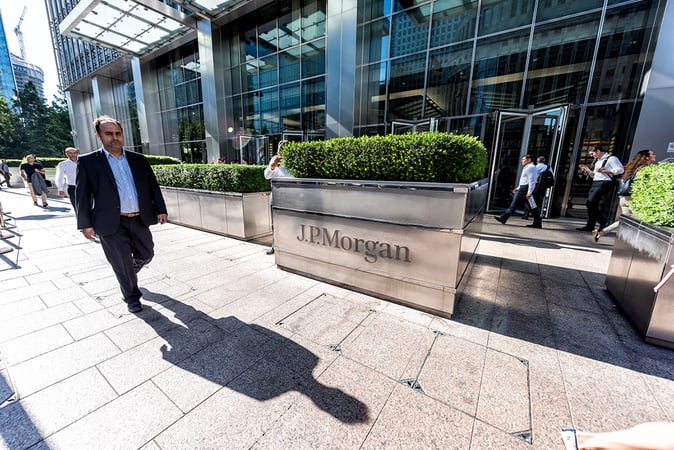The cryptocurrency market is no stranger to seismic shifts, and recent developments suggest another wave of change is on the horizon. JPMorgan Chase, one of the world’s leading financial institutions, has forecasted significant outflows from the Grayscale Bitcoin Trust (GBTC) following the approval of Ethereum (ETH) exchange-traded funds (ETFs) in July 2024. This prediction has sparked discussions among investors and analysts, as it could reshape the dynamics of crypto investment vehicles. In this article, we’ll explore JPMorgan’s forecast, the factors driving potential GBTC withdrawals, and what this means for the broader cryptocurrency market.
Understanding the Grayscale Bitcoin Trust (GBTC)
What Is GBTC?
The Grayscale Bitcoin Trust (GBTC) is one of the most prominent investment vehicles for institutional and accredited investors seeking exposure to Bitcoin (BTC) without directly owning the cryptocurrency. Launched in 2013, GBTC initially operated as a closed-end fund, offering a way to invest in Bitcoin through traditional brokerage accounts. In January 2024, it converted into a spot Bitcoin ETF following approval from the U.S. Securities and Exchange Commission (SEC), marking a significant milestone for the crypto industry.
Why Has GBTC Been Popular?
GBTC’s early dominance stemmed from its status as the only U.S.-based vehicle for Bitcoin exposure within traditional portfolios. Despite its high management fee of 1.5%, GBTC attracted significant capital, with assets under management (AUM) peaking at over $40 billion. Its August 2023 legal victory against the SEC, which paved the way for spot Bitcoin ETF approvals, further solidified its reputation as a pioneer in the crypto investment space.
However, GBTC has faced challenges in recent years, including substantial outflows totaling $21 billion since early 2024. The introduction of lower-cost Bitcoin ETFs, such as BlackRock’s iShares Bitcoin Trust (IBIT) with a 0.25% fee, has intensified competition, prompting investors to seek more cost-effective alternatives.
JPMorgan’s Prediction: Why GBTC Could See Large Withdrawals
The Impact of Ethereum ETF Approval
In July 2024, the SEC approved spot Ethereum ETFs, allowing investors to gain exposure to ETH through regulated investment vehicles. This development has been a game-changer, as Ethereum is the second-largest cryptocurrency by market capitalization and a cornerstone of decentralized finance (DeFi) and blockchain innovation. JPMorgan analysts believe that the launch of Ethereum ETFs could trigger significant capital shifts, particularly away from GBTC.
JPMorgan’s reasoning hinges on investor behavior observed after the approval of spot Bitcoin ETFs in January 2024. When Bitcoin ETFs launched, GBTC experienced massive outflows as investors moved to cheaper alternatives or capitalized on increased liquidity. A similar trend occurred with the Grayscale Ethereum Trust (ETHE), which saw $1.72 billion in outflows in its first five days of trading as an ETF. JPMorgan attributes these movements to investors’ preference for lower-cost funds and the opportunity to reallocate capital into new ETF offerings.
High Fees and Competitive Pressure
One of the primary drivers of potential GBTC withdrawals is its relatively high management fee. At 1.5%, GBTC’s fee is significantly higher than competitors like Fidelity’s Wise Origin Bitcoin ETF (FBTC) at 0.25% or Grayscale’s own Bitcoin Mini Trust (BTC) at 0.15%. This fee disparity has already led to $18 billion in outflows from GBTC since early 2024, as investors gravitate toward more cost-efficient options.
The approval of Ethereum ETFs adds another layer of complexity. Investors may see Ethereum as a compelling alternative to Bitcoin, given its role in smart contracts, DeFi, and tokenized real-world assets (RWAs). As a result, some GBTC investors might redirect capital to Ethereum ETFs, especially those with lower fees, such as BlackRock’s iShares Ethereum Trust (ETHA) or Fidelity’s Ethereum Fund (FETH).
Investor Reallocation Strategies
JPMorgan’s analysis suggests that investors are likely to rebalance their portfolios in response to Ethereum ETF approvals. For instance, institutional investors who previously allocated heavily to GBTC may diversify into Ethereum ETFs to capture exposure to both leading cryptocurrencies. This reallocation could accelerate GBTC outflows, particularly if Ethereum’s price performance outpaces Bitcoin’s in the coming months.
Moreover, the broader trend of institutional adoption of crypto ETFs supports JPMorgan’s prediction. Major banks like Goldman Sachs and Morgan Stanley have increased their exposure to Bitcoin and Ethereum ETFs, signaling growing confidence in digital assets. However, these institutions often prioritize cost efficiency, which could further pressure GBTC’s market share.
What This Means for the Crypto Market
Shifting Investor Preferences
The potential for large GBTC withdrawals reflects a broader shift in investor preferences within the crypto market. As more ETFs become available, investors are prioritizing lower fees, greater liquidity, and diversified exposure. Ethereum ETFs, in particular, offer a way to invest in a blockchain ecosystem that powers thousands of decentralized applications, potentially appealing to those seeking innovation beyond Bitcoin’s store-of-value narrative.
Grayscale’s Response: The Mini Trusts
Grayscale has not stood idly by in the face of competitive pressures. In July 2024, the firm launched the Grayscale Bitcoin Mini Trust (BTC) and Grayscale Ethereum Mini Trust (ETH), both with a low 0.15% management fee. These “spin-off” products were seeded by transferring 10% of GBTC and ETHE’s holdings, respectively, and have already attracted significant inflows, totaling $750 million in their first three months. By offering cost-competitive alternatives, Grayscale aims to retain investors and mitigate outflows from its legacy funds.
Long-Term Implications
JPMorgan’s forecast underscores the evolving nature of the crypto investment landscape. As regulatory clarity improves and new ETFs for altcoins like Solana and XRP potentially emerge, the market could see further capital reallocation. JPMorgan estimates that Solana and XRP ETFs could attract up to $14 billion in inflows within 12 months of approval, highlighting the growing appetite for diversified crypto exposure.
For GBTC, the challenge will be to maintain its dominance in a crowded market. While its $268.5 million in annual revenue still outpaces the combined revenue of other U.S. spot Bitcoin ETFs, sustained outflows could erode its AUM, currently at $19.28 billion. Grayscale’s ability to innovate and adapt will be critical to its long-term success.
Conclusion
JPMorgan’s prediction of large withdrawals from the Grayscale Bitcoin Trust (GBTC) following Ethereum ETF approvals highlights the dynamic and competitive nature of the cryptocurrency market. High fees, investor reallocation, and the allure of Ethereum’s ecosystem are driving forces behind this potential shift. While Grayscale faces challenges, its launch of low-cost Mini Trusts demonstrates a proactive approach to retaining market share.
As the crypto market continues to mature, investors can expect more opportunities to gain exposure to digital assets through regulated vehicles. For those considering GBTC or Ethereum ETFs, it’s essential to weigh factors like fees, market trends, and portfolio diversification. With the crypto landscape evolving rapidly, staying informed will be key to navigating this exciting yet unpredictable space.




